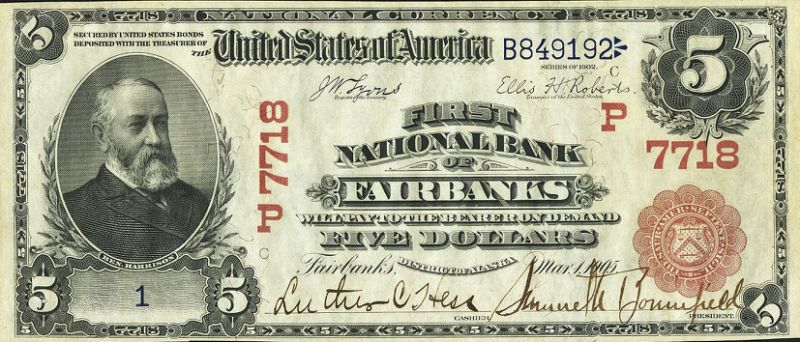By Rachel D’Oro | Associated Press – Wed, Oct 3, 2012 | Yahoo! News
(Photo Above: Associated Press/Heritage Auctions – In this photo provided by Heritage Auctions, the front of a 1905 $5 bill is shown. How do you turn a $5 bill into $200,000? Let it sit around a century or so. A Dallas auctioneer is about to off a $5 bill presented in 1905 to Vice President Charles W. Fairbanks _ Theodore Roosevelt’s No. 2 _ from the First National Bank of Fairbanks, Alaska. (AP Photo/Heritage Auctions)
ANCHORAGE, Alaska (AP) — The $5 bill displayed for decades on Charles Fairbanks IV’s wall was long a treasured family heirloom from Alaska. Now, to the surprise of the grandson of a turn-of-a-century vice president, it’s also become a likely treasure trove.
The rare find is expected to fetch as much as $300,000 at auction this month when a Texas auctioneer plans to put it up for bids in Dallas and online as part of the American Numismatic Association National Money Show.
The bill was presented in 1905 to Vice President Charles W. Fairbanks — Theodore Roosevelt’s No. 2 — and was from the First National Bank of Fairbanks, Alaska. The family has had it in their possession ever since and recently decided to auction it off through Dallas-based Heritage Auctions.
“It’s a wonderful, wonderful find,” said Dustin Johnston, director of Heritage’s currency auctions.
Auction officials say the Fairbanks bill that features an image of President Benjamin Harrison is a highlight that’s expected to sell for $200,000 to $300,000. The minimum starting bid is $120,000.
Fairbanks always knew the bill was special, at least to his family, given that it was presented to the former vice president as a memento from the frontier city named after him.
Fairbanks learned last year that the uncirculated note’s estimated value had skyrocketed far beyond the estimate of $50,000 to $60,000 set in the mid-1990s, which prompted him to start locking it up whenever he traveled.
With the new estimate, the 66-year-old great-grandson no longer felt comfortable displaying it on a wall in his Santa Barbara, Calif., home.
It was no longer just a framed family keepsake, so off it went to a safety deposit box.
“Why stress out and worry about something?” Fairbanks said. “It’d be like having a Monet in the house.”
But keeping it hidden didn’t do anyone any good. So Fairbanks decided to consign it to Heritage. He said his family has plenty of other historical memorabilia, or he wouldn’t have done it.
Charles W. Fairbanks was a U.S. senator from Indiana in the late 1890s when he was credited with playing a key role to resolve a border dispute with Canada triggered by the Klondike Gold Rush. As a result of his efforts, most of the disputed territory went to the United States.
But the real reason the city of Fairbanks was named after him was because he played a key role in the appointment of a federal judge, James Wickersham, a man Fairbanks met during the border dispute, according to University of Alaska Fairbanks historian Terrence Cole. To return the favor, Wickersham urged city founders to call the settlement Fairbanks.
“He said, ‘I owe everything that I am to him,'” Cole said.
Auction officials also note the bill’s rarity. Only three banks in Alaska — out of more than 12,000 banks nationwide — issued the bills.
According to Johnston, the Fairbanks bill was just one of four notes of its kind in the $5 denomination that were issued in 1905 by the Alaska bank, which was acquired by KeyCorp and became part of KeyBank. One of those bills sold 15 years ago for close to $100,000 and the market has “really picked up for the rarest pieces,” he said.
A third bill is in storage at the University of Alaska Museum of the North in Fairbanks, collections manager of ethnology and history Angela Linn said Wednesday. The bill is in pristine condition and looks as if it just came off the printing press, she said, adding that its distinctive quirk is a curve in part of the edge.
The bill being auctioned is unfolded and there is no wear, either, Johnston said. Its color is a little muted because the family displayed it for so long. There also have been some minor restorations to the back corners, but Johnston doesn’t expect that to affect the selling price, given the bill’s rarity, pedigree and history.
It’s probably one of the better national bank notes that will come to auction over this decade, he said.
“It’s easily in the top five of what I’ve handled,” Johnston said.




